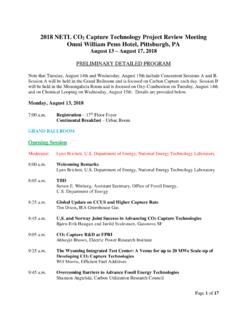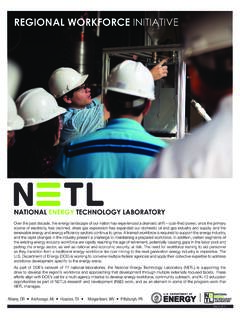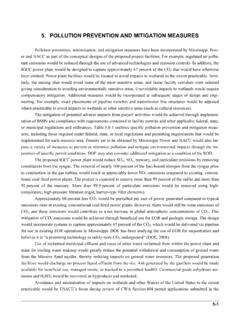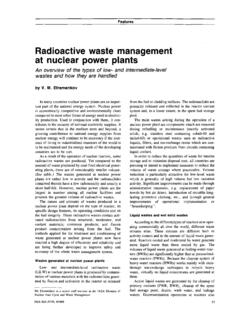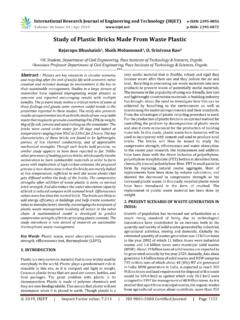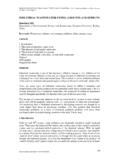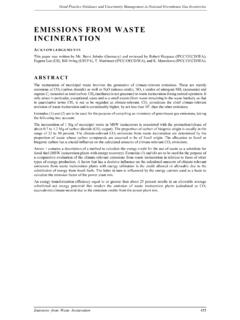Transcription of Biomass Gasification 101 - National Energy Technology ...
1 Steve JenkinsCH2M HILL Engineers, , FloridaBiomass Gasification 101 Edmonton, AlbertaJune 4, 20122 Topics What are pyrolysis and Gasification ? Historical uses for pyrolysis and Gasification Biomass Gasification technologies Municipal Solid Waste Gasification Gasification vs. Mass-burn Incineration Example projects 3 What are Pyrolysis and Gasification ?PowerFuelsChemicalsFertiliz ersSyngasFeedstockChar/ash4 What is Pyrolysis? Thermal decomposition of organic materials at 200-800 C, in the absence of air or oxygen, into liquids, gases or a combination of liquids and gases It s not combustion ; there s no burning! A mixture of un-reacted carbon char and ash remains as a residual5 Pyrolysis at Home67 What is Gasification ? Thermal conversionof carbon-based materials at 500-1,500 C, with a limited supply of air or oxygen, into a synthetic gas, or syngas It s not combustion ; there s no burning!
2 Gasification uses only a fraction of the oxygen that would be needed to burn the material An ash/slag remains as a residual Little to no un-reacted carbon char remains8 What s in the Syngas? Syngas contains mostly hydrogen (H2), carbon monoxide (CO), carbon dioxide (CO2), and water (H2O) it s notmethane (CH4), like natural gas Heating value is 5-16 MJ/kg (100-300 Btu/ft3) vs. natural gas at 52 MJ/kg (1,000 Btu/ft3) Syngas can be used a fuel for generating power, or to make chemicals, fuels, or fertilizers9 How has Pyrolysis been Used? Making charcoal from wood Making cooking additives Producing methanol ( spirit of wood ) Used by Kodak to make photo film10 How has Gasification been Used? Making town gas from coal (1792) Manufactured gas plants prior to discovery and widespread use of natural gas11 Town Gas Holders12 Town Gas ProductionSchwarze Pumpe, Germany13 How has Gasification been Used?
3 Cars and trucks used small wood gasifiers for fuelwood gasifier14 Biomass Gasification15 Feedstocks Wood waste (sawdust, bark) Cultivated crops (switchgrass) Agricultural wastes Animal wastes (stall waste) Waste Water Treatment Plant biosolids Municipal solid waste (MSW) Blends16 Feedstock Comparisons% Moisture% Ash% Volatile Matter% CarbonMJ/kg (Btu/lb) (14,100)Pet (14,050)Bituminous (11,100) (8,382)Subbituminous (8,156)Corn (7,782)Corn (7,369) (6,814) (6,800) (6,636)Chicken (6,310) (5,000)Dried (3,445)17 Biomass Gasification vs. combustion Wide range of feedstocks Easier to gasify some feedstocks than to try to burn them Environmental advantages over Biomass combustion : Concentrates ash contaminants in the gasifier, so that the boiler, reciprocating engine or gas turbine burns syngas, notthe actual Biomass Syngas can be piped to multiple users Ash/slag can be a usable by-product18 Biomass Gasifiers Typical Biomass gasifiers.
4 20 kg/hr to 300 tonnes/day Air-blown Atmospheric pressure 500-1,000 C Fixed bed or fluid bed Syngas is combusted directly in a boiler to make steam for a steam turbine generator 19 Biomass Gasifiers Many Types for Different Feedstocks and Applications 20 Fixed Bed Gasifier Updraft Feedstock is pre-dried before it gets to Gasification zone Can handle high moisture Biomass Heat source is oxidation of char Operates at low temperatures High amount of tar in syngas Must be cleaned prior to downstream useSyngas, tarsFeedstockC+CO2= 2 COC+H2O = CO + H2C+O2= CO2 Oxidation21 Fixed Bed Gasifier Downdraft Needs low moisture (<20%) and low ash Fines are a problem Heat source is oxidation of volatile gases Operates at high temperatures Low tars in syngasFeedstockSyngasC+CO2= 2 COC+H2O = CO + H2C+O2= CO222 Fluid Bed Gasifiers Good for low reactivity feedstocks Good for fines Air/sand bed mixture is fluidized Moderate temperatures Provides high turbulence and residence time High carbon conversion Syngas/ash/sand mixture exits to cyclone Ash/sand mixture is returned to bed Low tars in syngasFluidizing AirFeedstockCycloneSyngasAsh, sand, charFluidBedAsh23 MSW Pyrolysis and Gasification MSW typically requires significant pre-processing Removal/recovery of metals, paper, and glass.
5 Plastics plus shredding and sizing Enhancesexisting recycling programs Same/similar technologies as used for Biomass Some use pyrolysis Plasma Gasification may have advantages in some applications24 Plasma Gasification Uses plasma torch or carbon arc to supply heat/ Energy to initiate Gasification reactions or to improve quality of syngas produced from a conventional gasifier Plasma gas injected at up to 5,500 C Used for decades to destroy wastes and melt incinerator ash into slag Good for hard to gasify materials Operating plants in Canada and Japan25 MSW Gasification vs. Mass-burn Incineration26 Mass-burn Incineration Incineration literally means to render to ash Incineration uses MSW as a fuel It burns with large amounts of air to form heat and CO2 Hot exhaust gases are used to make steam, which is then used to generate electricity Emissions can only be removed aftercombustion27 MSW Gasification MSW is not a fuel, but a feedstockfor the Gasification process The MSW itself is notcombusted Gasification converts MSW to a usable syngas The MSW reacts with little or no oxygen and is converted to syngas The syngas (not the MSW)
6 Can be combusted to produce steam or electricity Or the syngas can be used to make higher valuable commercial products such as transportation fuels, chemicals, and fertilizers28 MSW Gasification Gasification does not compete with recycling; it actually enhancesit Metals and glass are removed from the waste stream prior to being fed into the gasifier Many plastics and cardboard boxes cannot by recycled, and would otherwise end up in a landfill They make excellent high Energy feedstocks for Gasification , reducing the amount that would otherwise end up in a landfill29 Dioxins and Furans Large organic molecules (like plastics) are decomposed into syngas in the high temperatures of the gasifier Dioxins/furans need sufficient oxygen to form, and the oxygen-efficient atmosphere in a gasifier does not provide the environment needed for that to occur Dioxins need fine metal particulates in the gas to reform.
7 Syngas from Gasification is typically cleaned of particulates beforebeing used30 Dioxins and Furans When syngas is used to produce fuels, chemicals and fertilizers, the syngas is quickly quenched, so that there is not sufficient residence time in the temperature range where dioxins/furans could re-form When the syngas is primarily used as a fuel for making heat, it can be cleaned as necessary beforecombustion; this cannot occur in incineration, which requires post-combustionclean-up31 Biomass Gasification Projects Many new Biomass Gasification projects are being developed Government incentives for bio- Energy production Typically for power production in 5-50 MW range Some will produce alcohols or transportation fuels Feedstocks include: Wood chips, bark Agricultural wastes Grasses MSW WWTP sludge or dried biosolids Animal stall wastes 32 Univ of British Columbia Biomass to power/CHPE nerkem MSW to alcoholsPlasco Energy MSW to PowerUniv Northern BC Biomass to central heatingBiomass and MSW Gasification Plants33 Edmonton Waste Management Centre Waste-to-Biofuels Facility MSW processed to refuse-derived fuel quality Enerkem - 100.
8 000 tonnes/year RDF fed to Gasification system RDF converted to syngas Syngas cleaned and converted to 36 million litres/year of alcohols 34 Plasco Trail Road FacilityOttawa Demonstration facility at 75 tonnes/day since 2006 Developing full-scale facilities in Canada and at 300-400 tonnes/day to generate 15-20 MW electricity to the grid35 Biomass and MSW Gasification PlantsTaylor Biomass Energy Biomass /MSW to PowerEnerkem Pontotoc MSW to AlcoholsUniv of South Carolina Biomass to power/steamMaxWest biosolids drying/thermal energyOak Ridge National Labs Biomass to steamBFC Gas & Electric Biomass to powerDixon Ridge Farms Biomass to power/heat36 Dixon Ridge Farms Walnut farm near Sacramento, CA Used significant amount of propane to dry the walnuts Now use 45 kg/hr walnut shells as feedstock for a Biomass gasifier Syngas is used for 50 kW power generation Heat from engine is used for drying the walnuts Offsets 20% of electricity use Offsets 40% of propane use37 Wastewater Treatment Plant Biosolids WWTPs want to use biosolids Gasification to meet internal heat and power requirements Biosolids can be a good feedstock for Gasification High moisture content is challenging Dried biosolids provide higher quality for Biomass gasifiers Opportunities to use waste process heat to dry the inlet biosolids High ash content and unique ash chemistry make ash handling a challenge38 MaxWest Environmental Systems WWTP biosolids Gasification facility in Sanford.
9 FL City WWTP needed to reduce use of natural to dry sludge to meet Class A biosolids for land application MaxWest system installed their facility at the WWTP Heat from combustion of syngas is used to dry incoming biosolids Significant reduction in use of natural gas for drying Small amount of ash for disposal39 Waste-to-Biofuels?40 Waste-to-Biofuels?41 Waste-to-Biofuels?42 Waste-to-Biofuels?43 Waste-to-Biofuels?44 Questions?45 Contact InfoSteve JenkinsTampa.

